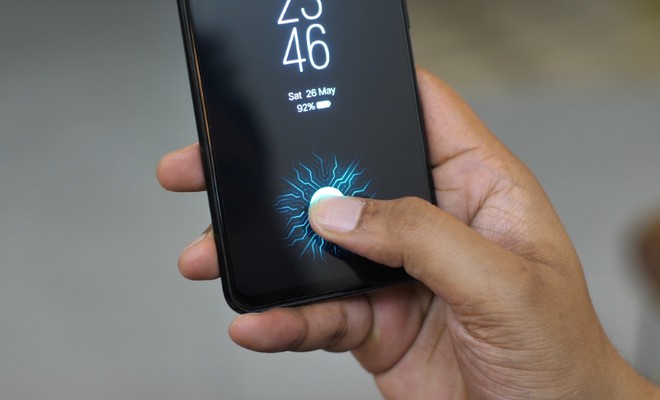How does the in-display fingerprint sensor work?
But what's behind this 'invisible' embedded fingerprint sensor technology? Let's learn through the article on the HowToGeek site to better understand this sensor technology.
What's different from a traditional physical fingerprint sensor?
Fingerprint sensor is like other forms of biometric identification, it is no stranger to modern computing devices like computers. Although the fingerprint sensor has been built into laptops for several decades, it only appeared on a mobile phone in 2004, the Pantech GI100. Since then, it has been reliably integrated into smartphone models due to the growing need for data security.
Currently, although Apple has completely replaced the Touch ID fingerprint sensor on the iPhone with Face ID facial recognition, the fingerprint sensor is still popular on most smartphone models on the market.
With the evolutionary momentum into facial recognition sensors, over the past few years many manufacturers have gradually replaced the physical fingerprint sensor with the in-display fingerprint sensor, allowing you to unlock the phone by placing your finger. hand over a specific area of the screen.
The process of unlocking the fingerprint on the screen

In general, the fingerprint scanning process of different types of sensors is similar, whether it is a physical fingerprint sensor or an embedded fingerprint sensor under the screen.
Normally, a specific part of the screen will be integrated with a fingerprint scanner hidden at the bottom, when you place your finger on that area it will take a snapshot of your fingerprint pattern with a separate sensor and compare with previously saved biometric data. If it matches it will open the screen immediately.
One of the biggest problems with in-display fingerprint sensors is the relatively small scanning area. It usually takes up a small portion of the bottom of the screen. Phone manufacturers often use an image to suggest a position for you to put your finger on, which usually appears when you raise your hand on the lock screen.
Depending on generation, technology, and software, fingerprint scanning can take place quickly or slowly.
Optical and ultrasonic sensors
There are two types of in-display fingerprint sensors popular today are the optical sensor and the ultrasonic sensor. In it, the optical fingerprint sensor will shine light on your finger (usually appear on the screen as an animation), then it will capture the fingerprint illuminated by the camera under the screen and compare with which it is available to decide whether to unlock the phone or not.

Many people believe that optical fingerprint sensor is less secure due to using a simple camera to capture fingerprints, but on the plus side, it is usually quite fast depending on software optimization.
The ultrasonic fingerprint sensor is generally considered to have better security because it uses the emitted ultrasonic waves to capture your fingerprint in 3D instead of using light, thus minimizing image spoofing. 2D fingerprints are inherently at risk of being bypassed in optical sensors. This technique is similar in medical ultrasound devices. It also works better in difficult conditions like dirty or wet fingerprints.
The future of in-display fingerprint sensors
In-screen fingerprints were born to minimize the appearance of unattractive 'holes' on the body, which is also the reason that many manufacturers are now looking to integrate the front camera into the screen or remove the jack. plug in the headset and other connection ports.
In the future, it is likely that in-screen fingerprint sensors will continue to be perfected and widely used, even with low-cost devices. Even, there are many rumors that Apple also wants to integrate fingerprint sensor technology into the iPhone screen next year, if it is true, this is not a new trend but only the evolution of Touch ID.
You should read it
- There are vulnerabilities that allow hackers to bypass the fingerprint security mechanism of Lenovo computers
- How to enable Full-Disk Encryption on Windows 10?
- Top 20 best encryption software for Windows
- Some common data security measures
- Find out how fingerprint security technology works
- Can the phone be unlocked by the fingerprint of the dead?
 What is MagSafe on iPhone 12? What is MagSafe used for on Apple devices?
What is MagSafe on iPhone 12? What is MagSafe used for on Apple devices? The world's first petabyte drive can use glass storage technology
The world's first petabyte drive can use glass storage technology Scientists create a biological eye, the day the blind see light is not far away
Scientists create a biological eye, the day the blind see light is not far away Arm introduces custom Cortex-A78 chip, Cortex-X and next-generation Mali-G78 GPU
Arm introduces custom Cortex-A78 chip, Cortex-X and next-generation Mali-G78 GPU Scientists have created the world's first liquid metal lattice
Scientists have created the world's first liquid metal lattice Scientists have found a way to 'characterize' directly on the human brain with electrical stimulation
Scientists have found a way to 'characterize' directly on the human brain with electrical stimulation